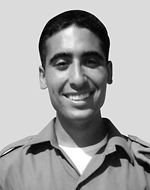Son of Marcel and Albert. He was born on 13.3.1982 in Afula. Brother to Haim and Einav. Shani grew up in a loving, loving family in Beit Shean and very quiet. As an outside child, he studied and was educated in the elementary school at Kibbutz Beit Hashita. He continued his studies at the ORT high school in Ein Harod, where he excelled in science and especially in computers. Due to the small age difference between the brothers Chaim and Shani – a year and a half – the two were always very close. “Only in the past few years, after everyone turned in his direction, did we see each other less, but even two weeks ago when we last saw him, we laughed together and went down on all the injustices in the world.” Shani was loved by his friends, who appreciated both his scholastic and social abilities. From an early age, Shani was distinguished by his creative talents: he photographed, painted and worked in computer graphics. Already during high school, he was the graphic designer for the weekly Beit Shean and the region, which in his design and development invested his energies and abilities. He was also a full partner in publishing the high school graduation book and was responsible for its graphic design. “My father had a dream that I would be an engineer and that two would be an architect, and that is how we will build houses together, and today this dream will not come true.” Immediately after graduating from high school, Shani joined the IDF on July 23, 2000. He served in the 8110 Infantry Battalion of the Nahal Brigade, as a combat soldier and a squad commander, and completed his service as a company sergeant (sergeant sergeant) And excelled in all his duties. “After the liberation,” said his brother Haim, “he had nothing else in mind except the trip to South America.” Shani planned his big dream: a big trip in South America. To achieve it, he worked tirelessly as a fuel and every casual job and even went to work in France, which included French language studies. When he returned to Israel he worked as a security guard in the construction of the separation fence on Mount Gilboa until he saved enough money to realize his dream, and traveled to South America for ten months. On the long trip – across the continent – Shanny met new friends and other lives. He traveled in enchanting landscapes and fascinating countries that were engraved in his memory, and when he returned home, he did not stop talking about them. Upon his return to Israel he began to acclimatize and shortly thereafter moved from his hometown of Beit She’an to the big city of Tel Aviv. He rented an apartment and began working in an electronic magazine as a graphic designer and programmer. At the same time, he was preparing for the architecture he wanted from his youth, studies for which his parents had already begun to pay their tuition. But the plans were cut short before they were realized. Four months after he landed in Israel, Shani received a reserve call-up order in the north, on the Lebanese border, in the reserve brigade of the Nahal Brigade, which began on June 18, 2006. “I asked him where he was and he told “I was very calm, so when I heard about the attack in the morning, I was not afraid at all.” On the morning of the last day of reserve duty, July 12, 2006, A few hours before his release, Shani and his friends left for a tour at 9:00 am, when Hezbollah attacked northern Israel with mortar and Katyushas. The Israeli army invaded the border area and attacked it from an ambush with anti-tank missiles.The two Hummer military vehicles were no longer used and began to burn. One of them was killed on the spot, and Sergeant Major Wasim Nazel and Lt. Col. (res.) Eyal Benin were killed. The squad took control of the main Hammer and kidnapped reserve soldiers, Major General Ehud GoldwasserTwo years later, their bodies were returned in a prisoner exchange deal between the State of Israel and Hizbullah, and another squad, armed with light weapons and machine guns, backed the kidnappers, and two soldiers were wounded. Led to the Second Lebanon War, when he was killed in a military operation in southern Lebanon, and was brought to rest in the military section of the Beit She’an cemetery, where he was succeeded by his
